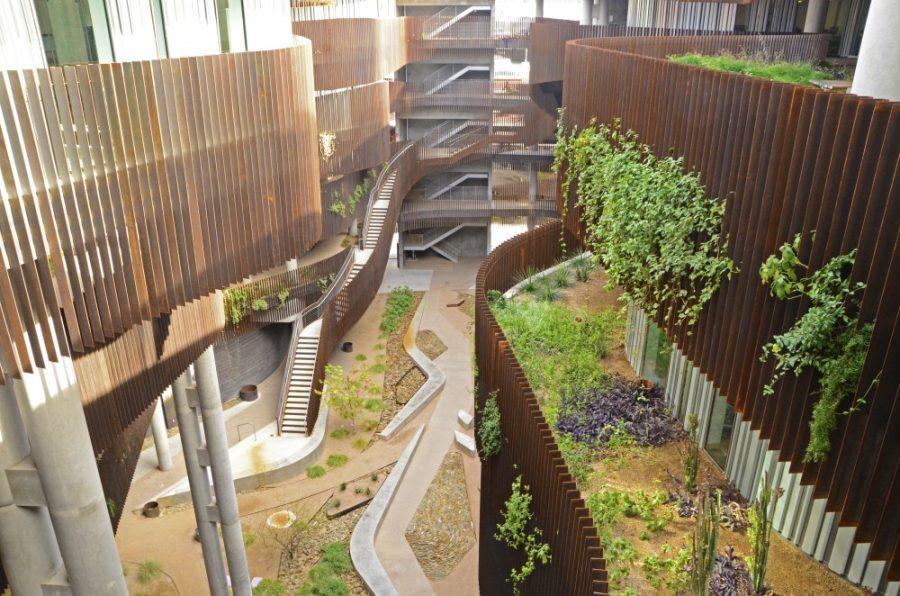A campus and institution bathed in tradition, the University of Arizona boasts an array of historic and progressive campus designs that contribute to the UA experience and celebrate its growth.
On the morning of Dec. 7, 1941, the battleship USS Arizona was bombarded with artillery that ignited the ammunition magazines and ripped the ship apart, sinking it within minutes. The USS Arizona still lies in shallow water where it hit the harbor bed 76 years ago. Of the 1,177 sailors and marines killed on the ship, 1,102 sunk with its remains.
The ship is a source of pride for the state, and the UA has the honor and privilege of retaining its legacy. Memorials dot the landscape and line the halls of the historic campus. An exact outline of the USS Arizona is inscribed on the UA Mall and provides an imposing testament to the scale of the warship. The mast bell, salvaged from the wreck, sounds daily from the Student Union Memorial Center, also structurally inspired by the USS Arizona. The university, quite literally, rings with the memory of the ship and its crew.
The responsibility of the UA to care for collective history does not end with the USS Arizona. There is a unique relationship between the state and its first university, which bears its name. The UA campus is truly a desert gem on various fronts, with benefits that run deeper than just pleasant appearance.
When certain qualities of good architecture and landscape design intersect with tradition and purpose, it enhances the academic quality of many institutions. Museums, public parks, houses of government, religious sites, research environments and universities share a critical common denominator: utilizing design and structure to instill purpose.
RELATED: UA community collaborates on growing sustainable campus
Modern concepts of structural identity have roots in the forms of location, material, utility, balance and symmetry. These aspects translate to ideology through application. Gothic cathedrals used unforgiving and exquisite details in their structures to express the authority of state and church. Washington D.C.’s neoclassical symmetry expresses ideas of public self-governance, classical liberalism and rule of law. Thus, universities are no exception to ideological forms.
The UA is home to a canon of monumental constructions that satisfy structural formality and psychological effectiveness. It is a known concept that different styles of architecture produce alternate cognitive responses through creativity, focus, memory and more.
WIRED Magazine documented this phenomenon in an article titled, “The Psychology of Architecture.” Several studies conducted by the University of British Columbia and the University of Minnesota’s Carlson School of Management determined that factors like color, furniture type, interior and exterior designs and placement accentuate certain academic qualities like ingenuity and concentration.

A few examples of campus constructions that show the university’s pleasant design, both time-honored and contemporary, include Cochise Hall, the Arizona State Museum, the Environment and Natural Resources 2 Building and the several USS Arizona memorials.
Cochise Hall, built in 1921, dawns Corinthian columns, classically inspired stone edifices and high interior ceilings. The use of classic greek orders is a theme replicated across campus. These designs inspire free thought, reason and contemplation.
RELATED: UA offers high-tech labs for students to explore, work
The Arizona State Museum,an example of traditional redbrick construction on campus, was founded in 1893 and remains the oldest and largest collection of anthropological artifacts in the American Southwest. Upon arrival, one is confronted by a series of massive, arched windows flanked by columned wings that provide a sense of completion. The building is reminiscent of classic Roman balance; yet, its arched redbrick and simple design add a more modern architectural accent. The museum facade evokes importance and cultural value.
However, not every building on campus is conservative in form. ENR2, which was completed in the summer of 2015, is one of UA’s most recent additions. At its core, ENR2 boasts a soaring atrium, open to the sky and modeled after a desert slot canyon. The innovative building is a nod to the topography of the region and to the university’s research capabilities.
The UA solidifies its reputation as a renowned institution of higher learning, statewide and beyond, by engaging in necessary academic endeavors, pertinent research and a general commitment to civic promotion. A fitting representation of institutional excellence displayed here is the accompanying campus aesthetic that looks to its past while ushering in its future.
-Eric Roshak is a sophomore majoring in Political Science and Law. He takes great pride in the UA’s history and believes the campus speaks to its achievements.
Follow Eric Roshak on Twitter















